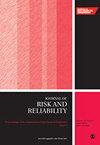Gear fault diagnosis based on bidimensional time-frequency information theoretic features and error-correcting output codes: A multi-class support vector machine
IF 1.8
4区 工程技术
Q3 ENGINEERING, INDUSTRIAL
Proceedings of the Institution of Mechanical Engineers Part O-Journal of Risk and Reliability
Pub Date : 2024-06-01
DOI:10.1177/1748006x241254603
引用次数: 0
Abstract
Fault diagnosis of gears plays an important role in reducing downtime and maximizing efficiency of rotating machinery. Vibration is popular parameter for gear fault detection. The occurrence of faults produces recurring transient impulses in the gear vibration signals. However, these transient features are heavily masked by background noises making it difficult to investigate gear faults. Furthermore, the development of automated fault diagnosis techniques requiring minimal human supervision poses another big challenge. Consequently, in this paper, an automated fault diagnosis technique based on a novel information theoretic (IT)-derived-feature set and an artificial intelligence technique called as error-correcting output codes-support vector machine (ECOC-SVM) is proposed. The gear vibration signals are first processed by continuous wavelet transform to obtain the corresponding time-frequency distributions (TFDs). The TFDs of the faulty signals are then discriminated from those of the healthy ones by introducing IT measures, namely, Kulback-Leibller divergence (KLD), Jensen-Shannon divergence (JSD), Jensen-Rényi divergence (JRD), and Jensen-Tsallis divergence (JTD). These uni-dimensional-IT measures are modified to accommodate the bidimensional TFDs, and the resultant features are referred to as bidimensional time-frequency information theoretic divergence (BTF-ITD) features. The BTF-ITD features are then used to train the ECOC-SVM model. Finally, the trained ECOC-SVM model is used for testing the gear faults. The ECOC approach rectifies the biases and errors in SVM model predictions. The experimental results confirm that the proposed approach provides higher classification accuracy than time-domain features; voting-based-multiclass SVM; and deep learning techniques, such as those based on the stacked sparse autoencoder (SSAE), deep neural network (DNN), and convolution neural network (CNN).基于二维时频信息论特征和纠错输出编码的齿轮故障诊断:多类支持向量机
齿轮故障诊断在减少停机时间和最大限度提高旋转机械效率方面发挥着重要作用。振动是齿轮故障检测的常用参数。故障的发生会在齿轮振动信号中产生反复出现的瞬态脉冲。然而,这些瞬态特征被背景噪声严重掩盖,因此很难对齿轮故障进行调查。此外,开发自动故障诊断技术需要最少的人工监督也是一大挑战。因此,本文提出了一种自动故障诊断技术,该技术基于新颖的信息论(IT)特征集和一种名为纠错输出编码支持向量机(ECOC-SVM)的人工智能技术。首先对齿轮振动信号进行连续小波变换处理,以获得相应的时频分布(TFD)。然后,通过引入 IT 测量,即 Kulback-Leibller 发散(KLD)、Jensen-Shannon 发散(JSD)、Jensen-Rényi 发散(JRD)和 Jensen-Tsallis 发散(JTD),将故障信号的 TFD 与健康信号的 TFD 区分开来。为了适应二维时频信息论发散,对这些单维信息论度量进行了修改,得到的特征被称为二维时频信息论发散(BTF-ITD)特征。BTF-ITD 特征随后用于训练 ECOC-SVM 模型。最后,训练好的 ECOC-SVM 模型用于测试齿轮故障。ECOC 方法纠正了 SVM 模型预测中的偏差和误差。实验结果证实,与时域特征、基于投票的多类 SVM 和深度学习技术(如基于堆叠稀疏自动编码器 (SSAE)、深度神经网络 (DNN) 和卷积神经网络 (CNN) 的技术)相比,所提出的方法具有更高的分类准确性。
本文章由计算机程序翻译,如有差异,请以英文原文为准。
求助全文
约1分钟内获得全文
求助全文
来源期刊

Proceedings of the Institution of Mechanical Engineers Part O-Journal of Risk and Reliability
ENGINEERING, MULTIDISCIPLINARY-ENGINEERING, INDUSTRIAL
CiteScore
4.50
自引率
19.00%
发文量
81
审稿时长
6-12 weeks
期刊介绍:
The Journal of Risk and Reliability is for researchers and practitioners who are involved in the field of risk analysis and reliability engineering. The remit of the Journal covers concepts, theories, principles, approaches, methods and models for the proper understanding, assessment, characterisation and management of the risk and reliability of engineering systems. The journal welcomes papers which are based on mathematical and probabilistic analysis, simulation and/or optimisation, as well as works highlighting conceptual and managerial issues. Papers that provide perspectives on current practices and methods, and how to improve these, are also welcome
 求助内容:
求助内容: 应助结果提醒方式:
应助结果提醒方式:


